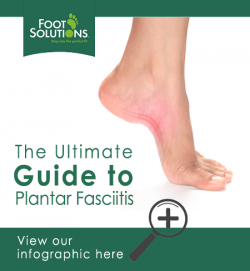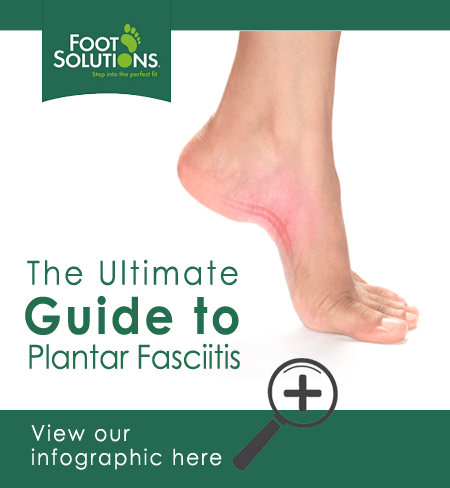Plantar fasciitis is a painful condition in which the plantar fascia, the long ligament that connects the heel to the ball of the foot, becomes aggravated, inflamed or torn. If untreated, the condition will worsen, and could lead to further problems such as heel spurs and problems with walking.
If you have been diagnosed with plantar fasciitis, your doctor will probably have advised you to rest the foot, and to carry out specific exercises if they are relevant in your case. Talk to us at Foot Solutions to find out how your footwear can help you to heal, and can prevent you from developing further problems in the future.
Pain Relief For Plantar Fasciitis:
 Plantar fasciitis often develops after repetitive exercise, such as running, or during pregnancy, when the extra weight carried can place the feet under increased pressure. You should seek advice from a medical professional if you think you have developed plantar fasciitis, since the specific medical advice will depend on the severity of your case. However, the following are some of the most effective ways to combat this painful problem:
Plantar fasciitis often develops after repetitive exercise, such as running, or during pregnancy, when the extra weight carried can place the feet under increased pressure. You should seek advice from a medical professional if you think you have developed plantar fasciitis, since the specific medical advice will depend on the severity of your case. However, the following are some of the most effective ways to combat this painful problem:
- Rest. Putting your feet up is a proven method of healing plantar fasciitis, so it’s important to allow yourself time to rest. You will probably need to take a complete break from exercising for at least a couple of weeks, and you should take advice on when to incorporate this back into your routine.
- Anti-inflammatory medication. Anti-inflammatory medication may be effective at reducing the pain of plantar fasciitis, and this may be over the counter painkillers, or a cortisone injection offered by your doctor. This will help to relieve pain, but should be used with caution to ensure you do not do further damage while the symptoms are masked.
- Ice applications. Ice can be effective at reducing the swelling – and therefore the pain – associated with plantar fasciitis. Using ice packs on the affected area is often advised, and this can be very helpful after stretching, or if you have had to stand or walk around for long periods.
- Custom inserts. If you have noticed heel pain when wearing specific shoes, you may need to consider changing your footwear or trying custom inserts. These are designed to fit your foot exactly, so they offer the maximum support and increase the effectiveness of the healing process.
- Specific stretches. Plantar fasciitis is often caused by exercise, especially if this is carried out on a hard surface or involves repetitive movements, such as running or playing tennis. Specific exercises that aim to stretch the plantar fascia in a gentle way to promote healing can be very helpful, and you may be referred to a physiotherapist to be taught these.
Prevent Foot Pain With Stylish Shoes In Ireland
Here at Foot Solutions, we know about footwear! We can advise you on the best styles and options for you, and we can give you more information about how to protect your feet and prevent foot pain. Pop into your local store to try our latest ranges, and talk to our helpful staff today.

































